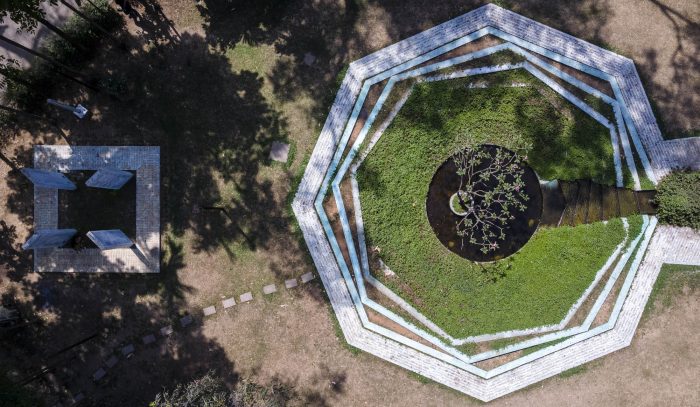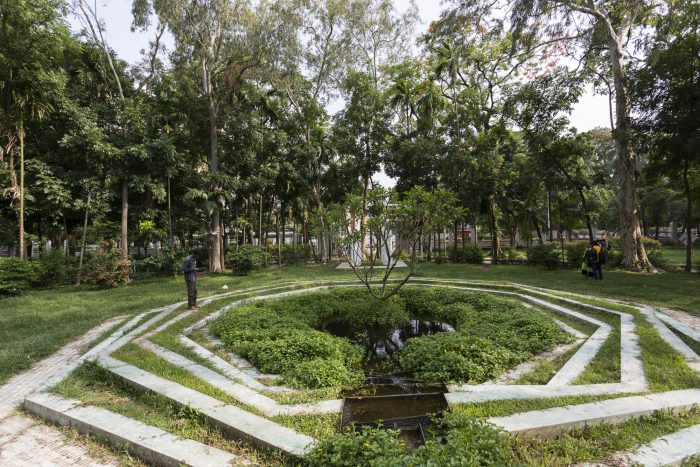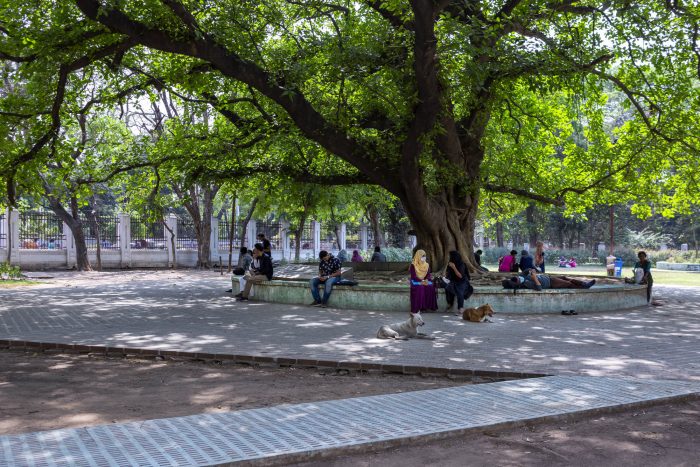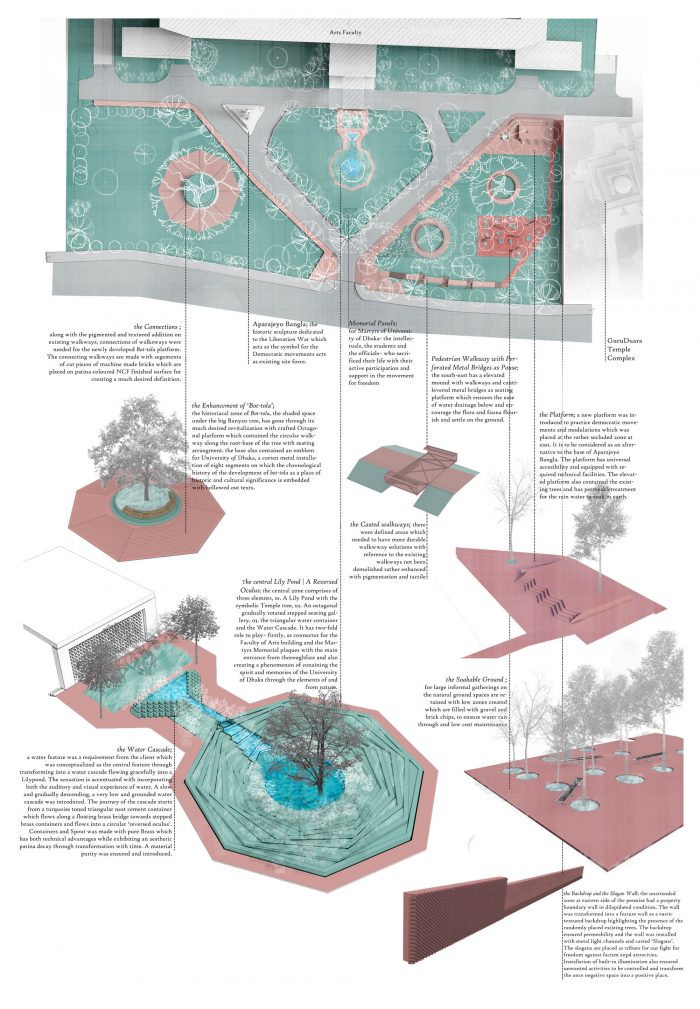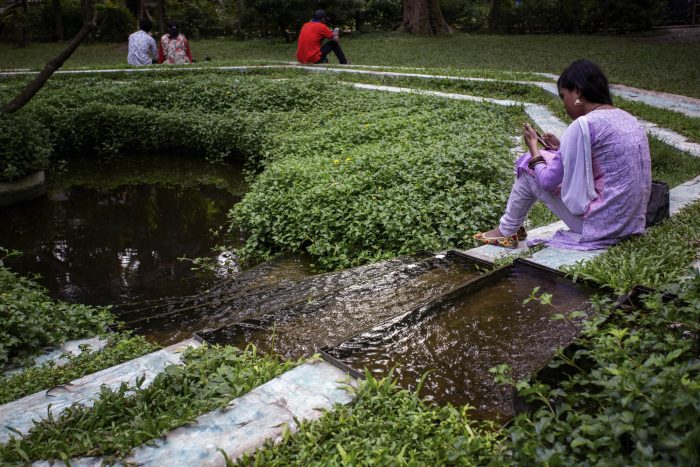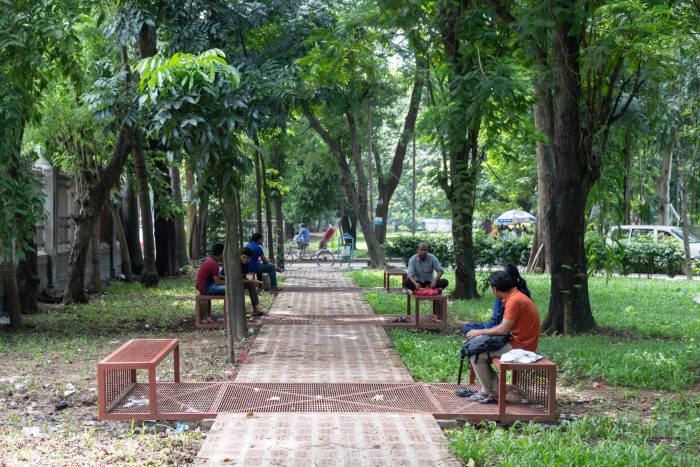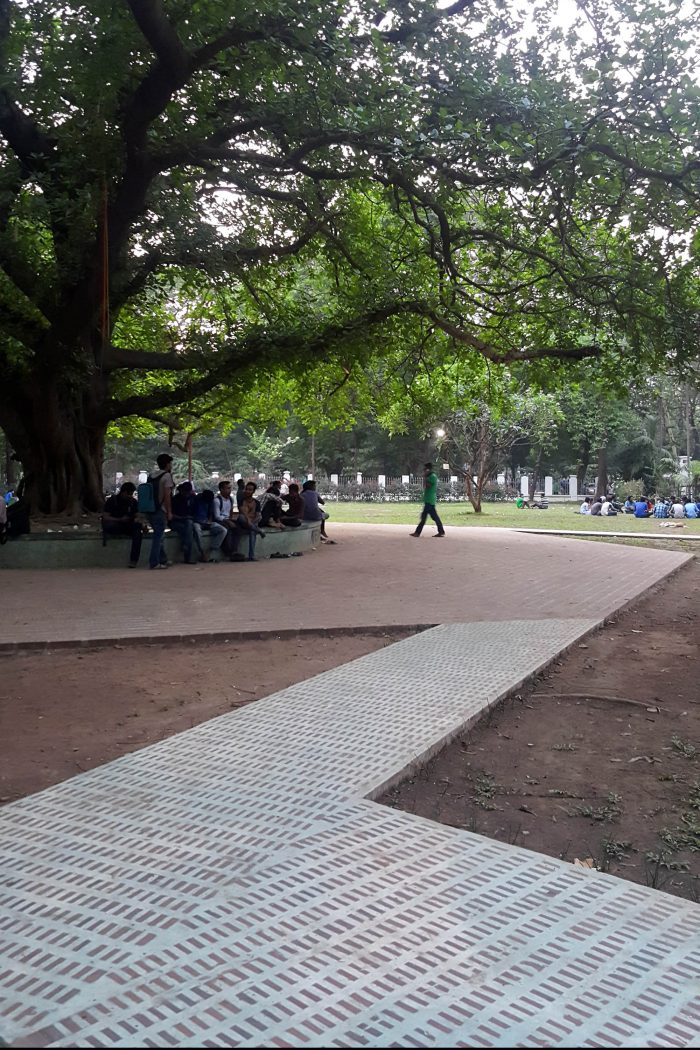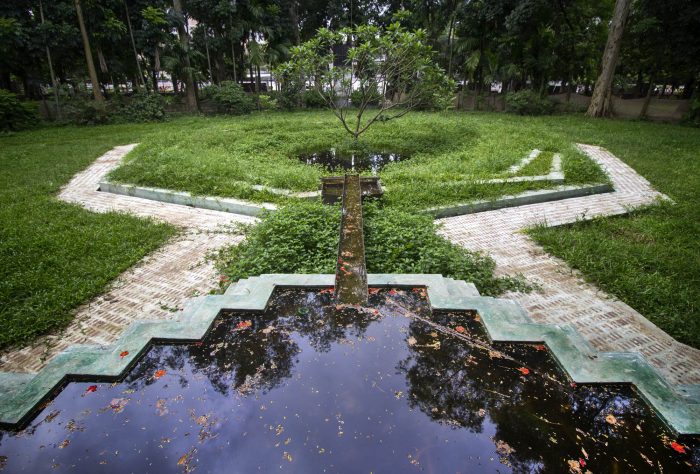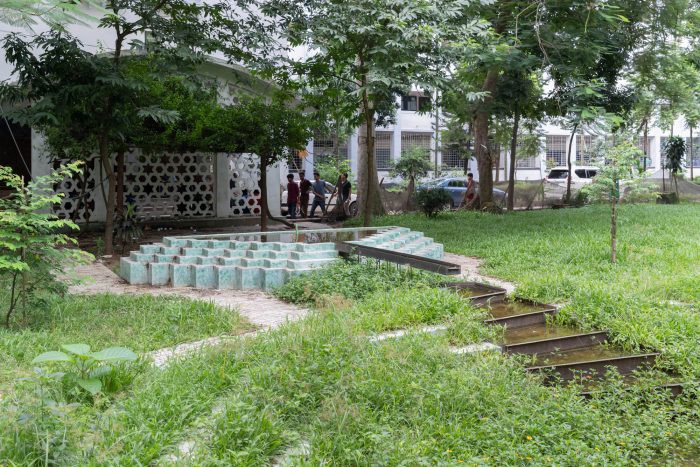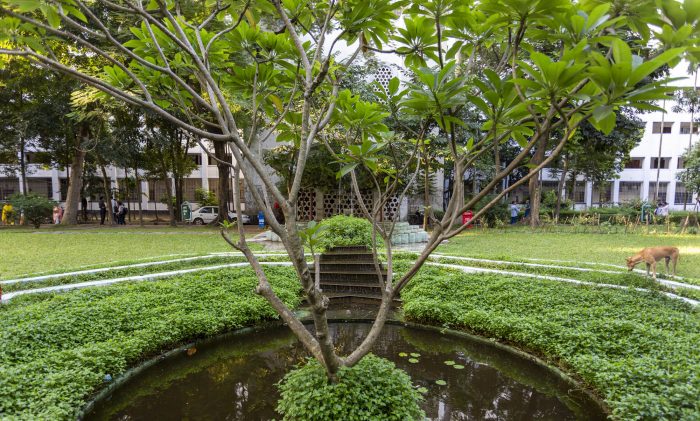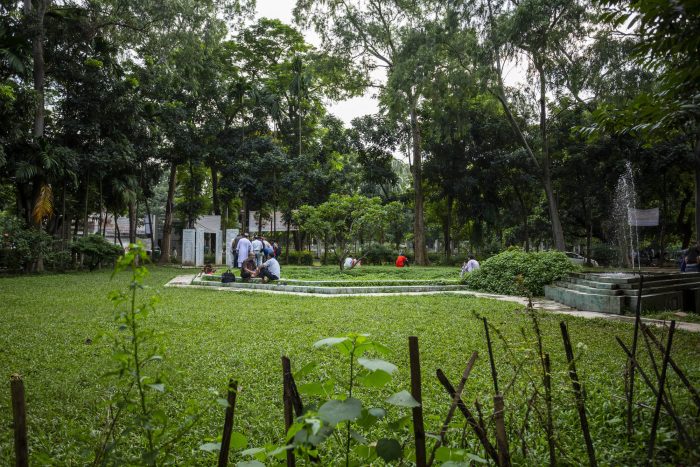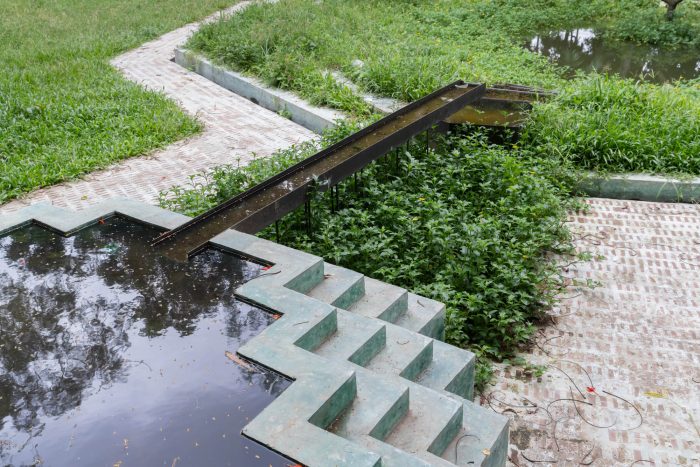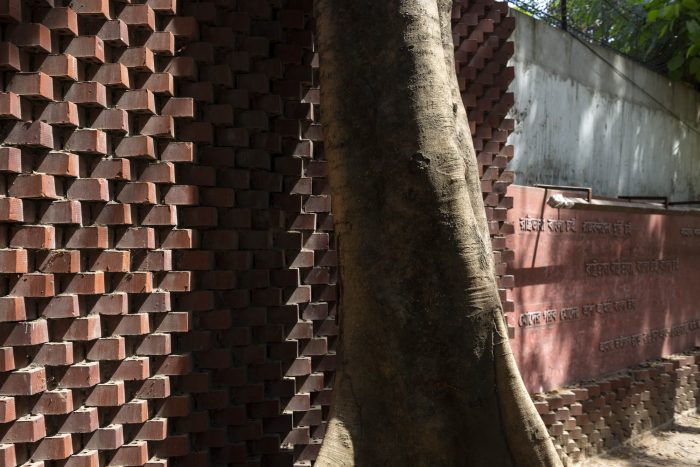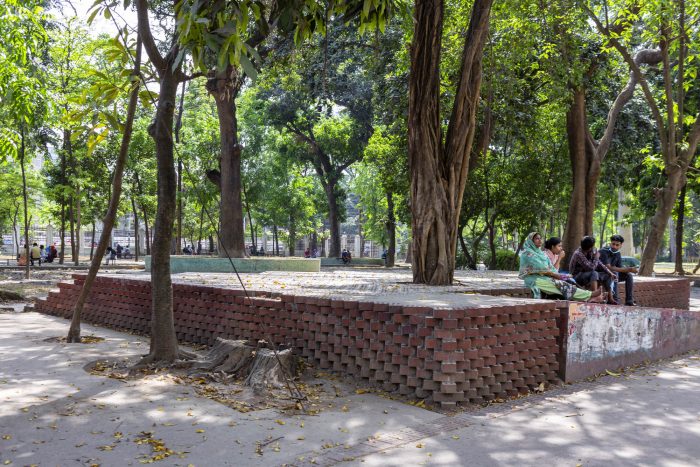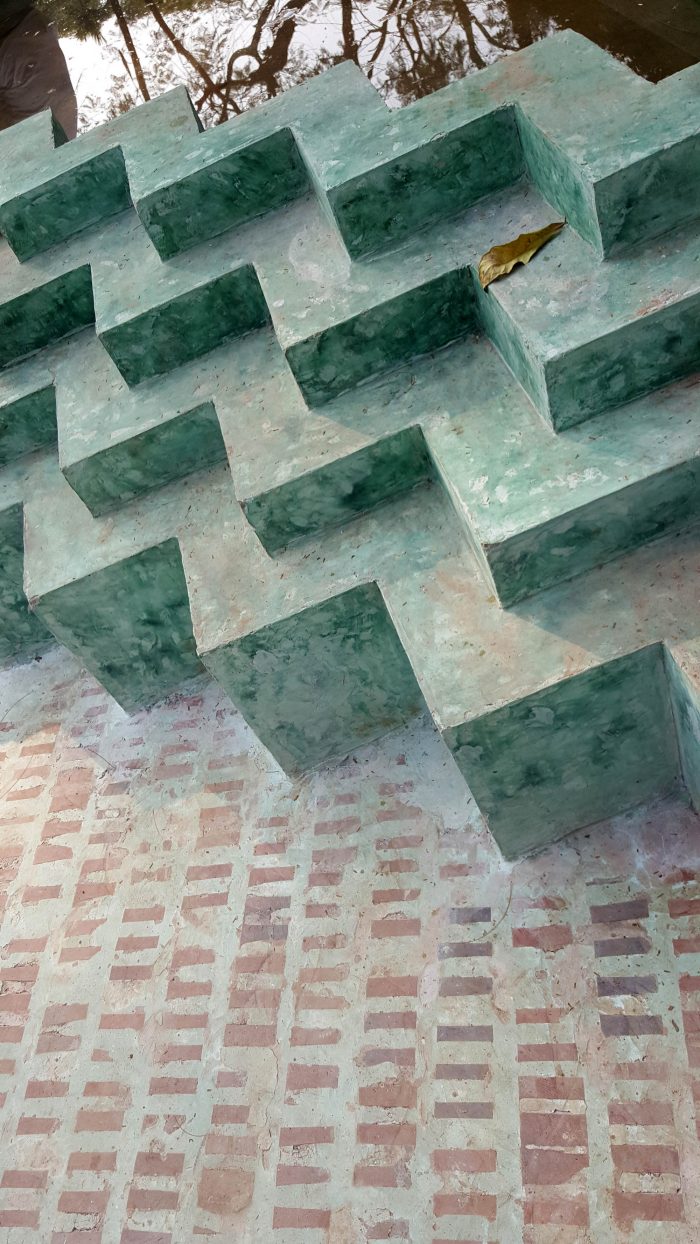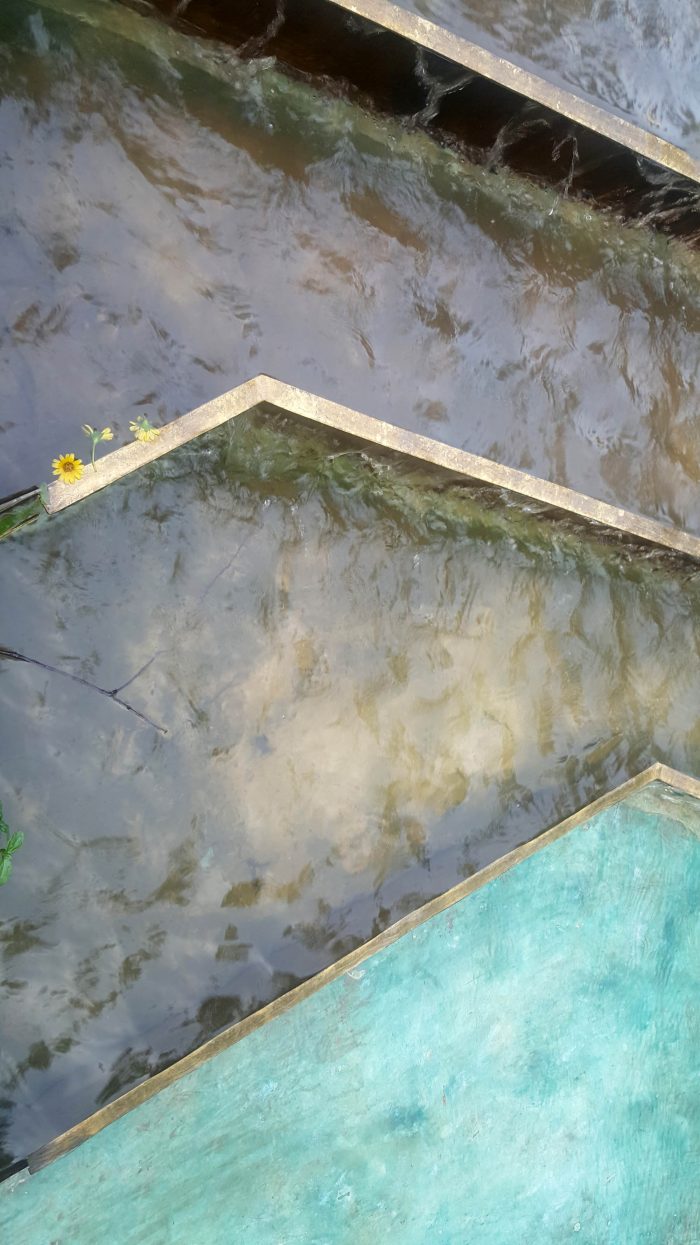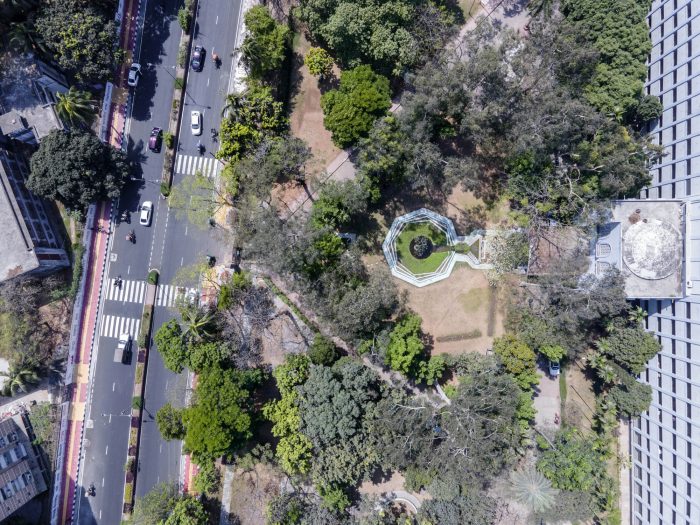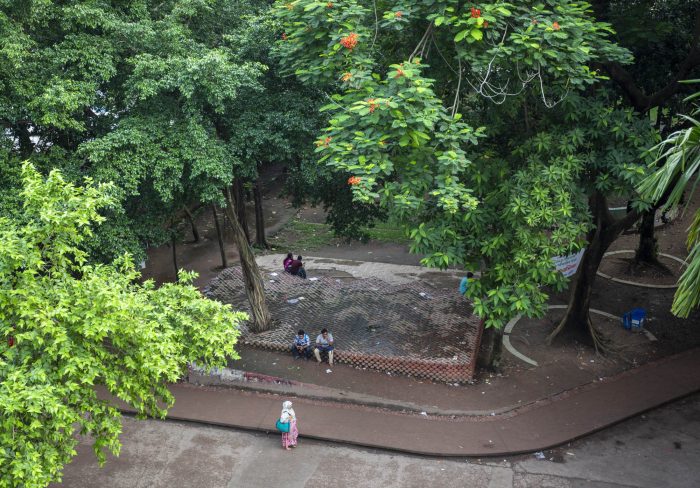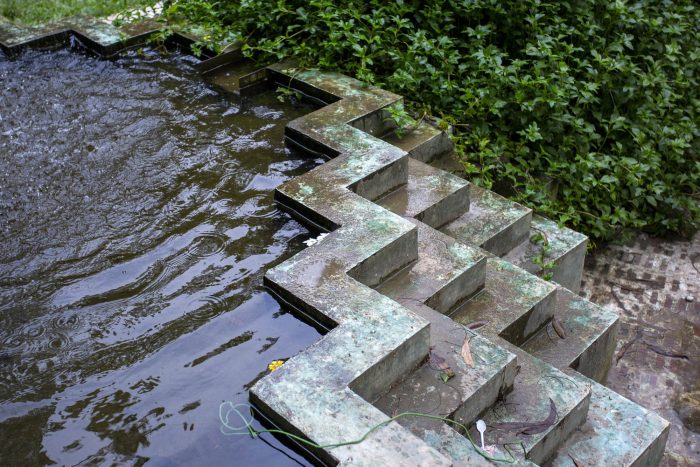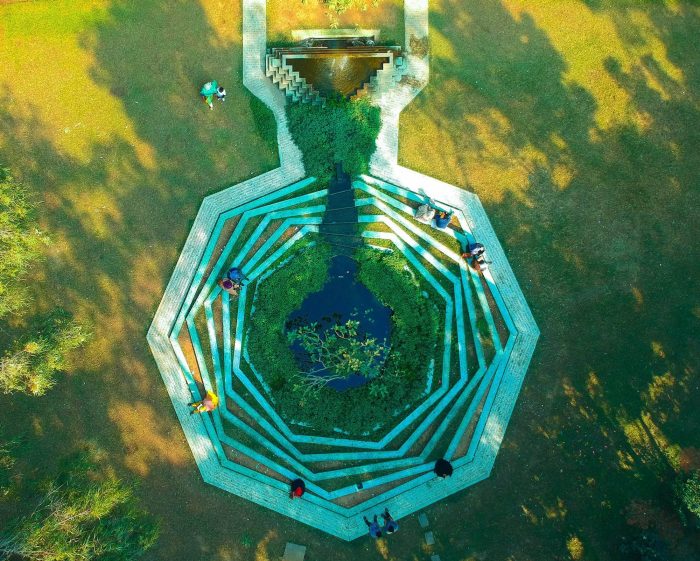达卡大学文学院被认为是一个具有历史和文化意义的中心,它包含了代表孟加拉国解放战争的最重要的纪念碑,一个名为Aparajeyo Bangla(意为未被征服的孟加拉)的地标性雕塑和历史悠久的Bot-tola(一棵大榕树)。大学当局希望通过对场地的景观设计干预,为用户创造指定的空间来解决一些问题。前提被划分为。
The premise of Faculty of Arts at Dhaka University is regarded as a center of historic and cultural significance which contains the most substantial monuments representing the Liberation War of Bangladesh, a landmark sculpture named Aparajeyo Bangla (meaning Unvanquished Bengal) and historic Bot-tola (a large Banyan Tree). The university authority wanted to address some issues by creating designated spaces for users through landscaped design interventions for the site. The premise was divided into;
位于主入口轴线上的三角形中心区。
含有历史悠久的Bot-tola(大榕树周围的地方)的西区。
东部地区,需要引起重视,几十年来一直被用作负面空间。
Triangular Central-Zone at the axis of main gateway
Western-Zone containing historic Bot-tola (the place surrounding a large Banyan Tree)
Eastern-Zone, which needed much attention which was being used as a negative space for decades.
自然环境是有组织的,也是随机的,树木层层叠叠,如Shegun、雨树、桃花心木、桉树、Krishnachura、Bakul、芒果、橡胶、Kanchan和Kurchi树,地面覆盖着草。Bot-tola(重新种植的榕树在1971年被连根拔起)是20世纪60年代群众起义的中心。
Natural setting was both organized and random with layers of trees like Shegun, Rain-tree, Mahogany, Eucalyptus, Krishnachura, Bakul, Mango, Rubber, Kanchan and Kurchi trees with grass as ground cover. The Bot-tola (replanted Banyan Tree which was uprooted in 1971) was the epicenter of mass uprisings in 1960s.
目的是为年轻人创造一个聚会的场所,作为学生和教师的沉思之地。由于该地块已有主要的地标建筑,新的功能被设想为补充和增强气氛。景观设计策略是通过自然元素的可识别整合,将每个元素编织在单一的公共矩阵上。
Objective was to create a meeting place for young minds to act as a place for contemplation for students and faculties. With major landmarks already existing in the site, the new features were conceived to complement and enhance the atmosphere. The landscaping strategy was to weave each element on single sheet of public matrix by recognizable integration of natural elements.
观念。
中心区的瞬时象征意义:旋转的八角形几何图形聚集了周围的气氛,并从其水面中心散发出一种精神上的宁静,使整个前提保持在一个连续的状态。瀑布落到宁静的百合池,一棵寺庙的梅花树从水土深处升起。中央三角区南角竖立了四块纪念牌,以纪念解放战争中的烈士。
Inceptions:
Transient Symbolism of Central Zone: Geometry of rotating octagons gathers the surrounding atmosphere and disperses a spiritual tranquility from its watery center, holding the whole premise into one continuum. A cascade falls to a serene lily pond where a temple tree (plumera) rises from the depth of watery earth. Four commemorative plaques have been erected at the south corner of central triangular zone, dedicated to the memories of the martyrs of liberation war.
展开的微妙在东。一个没有象征意义的民主空间,同时消除了约束。策略性的设计决策,将消极的空间转化为无障碍的活动空间。未被开发的空间被转化为所有的异常,并成长为一个新颖的介绍。
历史徽记在西。地标 “bot -tola “反映了孟加拉人的意识和对自由的不屈不挠的渴望。有一个 “明显的麻木”,要通过引入八角形图案的砖台围绕榕树和信息文字装置,用铁锈金属将其转化为动画。
Unfolded Subtlety at East: A democratic space devoid of symbolism while removing constrains. Strategic design decisions were taken to transform negative spaces into accessible event spaces. Unexplored spaces were transformed all anomalies and grew into a novel introduction.
Historical Emblem at West: The landmark ‘bot-tola’ is a reflection of Bengali consciousness and indomitable yearning for freedom. There is an ‘apparent numbness’ to be transformed into an animated one by introducing an octagonal patterned brick platform surrounding the banyan tree and informative text installation with rust metal.
介入方式。
工艺材料性。当地材料的获得,并以创新和新颖的操作人员进行测量。 通过使用当地的砖块、切割砖和砖片,并参照现场发现的色彩调色板,采用水泥饰面,实现了当地工艺和机器制造美学的诚实遏制,同时引入低碳钢和纯黄铜瓷,所有这些都溶入了一个体验性的形象。
Interventions:
Crafted Materiality: Local Materials obtained and measured with innovative and novel operatives. An honest containment of local craftsmanship and machine made aesthetic was achieved by using local bricks, cut bricks and brick chips with pigmented Cement Finished surfaces in reference to site-found colour palettes while introducing Mild-steel and Pure Brass-patina where all these dissolve into an experiential-image.
编排的体验:通过通道、平台和连接,用户在体验和存在的过程中被引导并获得自由。功能有明确的定义,有一种无所不在的空间联系感。遵循编排的模式,让使用者感受到一种连续性,并在他们的意愿和同意下找到停顿。
Choreographed Experience:Through walkways, platforms and connections user is guided and given liberty while experiencing and being at the place. Functions have clear definitions with a sense of omnipresent spatial connections. A choreographed pattern to follow for sensing a continuity for the user and also finding pauses at their will and consent.
结果。
随着时间的推移而改变:随着可用性的提高和附加功能的增加,空间变得既可进入又可渗透。在保持规模的同时,消除了限制因素,结果是各区域都有自己的特色。设计的功能与现有的元素一起发展出一种理想的动态,同时自然元素也在其中进行了自我改造。
Result:
Transformation with Time: With increased usability and added features spaces become both accessible and permeable. The constraints were removed while keeping the scale and as a result the zones breathe with their own identity. The designed features along with existing elements developed a desirable dynamics in between while the natural elements transformed itself within.
现象学形象。一个由人类干预定义的自然环境,与自然和人工形式不断对话。在这里,用户的体验依赖于个人映射的记忆和思考的联系。
Phenomenological Image: A natural setting defined by human interventions where constant dialogue is set with both natural and artificial forms. Here the user experiences rely on memories and contemplated connections of individual mapping.
建筑师:STHANIK Consultants
面积:81250平方英尺
年份:2017年
摄影作品:Noufel Sharif Sojol, Saiqa Iqbal Meghna, Iwan Baan, Mohammad Shamim
制造商:AutoDesk, Mirpur Ceramic, Rhino
牵头建筑师:Saiqa Iqbal Meghna, Suvro Sovon Chowdhury
建设:Arcadia,Nazmul Ahsan
图文说明:Bin Sayeed Bakhti
建筑师:STHANIK Consultants
城市:达卡
国家:孟加拉国
Architects: STHANIK Consultants
Area: 81250 ft²
Year: 2017
Photographs: Noufel Sharif Sojol, Saiqa Iqbal Meghna, Iwan Baan, Mohammad Shamim
Manufacturers: AutoDesk, Mirpur Ceramic, Rhino
Lead Architects: Saiqa Iqbal Meghna, Suvro Sovon Chowdhury
Construction:Arcadia, Nazmul Ahsan
Graphic Illustration:Bin Sayeed Bakhti
Architects:STHANIK Consultants
City:Dhaka
Country:Bangladesh


